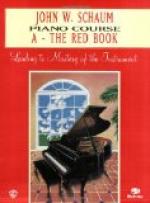HAND POSITION
The first principle a piano teacher shows his pupil is that of hand position. It has been my effort to secure a definite expression on this point from various artists. Most of them agree that an arched position with rounded finger joints is the correct one. It was Paderewski who said, “Show me how the player holds his hands at the piano, and I will tell you what kind of player he is”—showing the Polish pianist considers hand position of prime importance.
“I hold the hand arched and very firm,”—Ernest Schelling.
“The hand takes an arched position, the finger-tips forming a curve on the keys, the middle finger being placed a little farther in on the key than is natural for the first and fifth.”—Katharine Goodson.
“The hand is formed on the keys in its five-finger position, with arched knuckles.”—Ethel Leginska.
“The hand is formed in an arched position, with curved fingers, and solidified.”—Carl Roeder.
“The hand, in normal playing position, must stand up in well arched form, with fingers well rounded.”—Thuel Burnham.
“I first establish an arched hand position, with firm fingers.”—Edwin Hughes.
“I teach arched hand position.”—Alexander Lambert.
“One must first secure an arched hand, with steady first joints of the fingers.”—Eleanor Spencer.
“The first thing to do for a pupil is to see that the hand is in correct position; the knuckles will be somewhat elevated and the fingers properly rounded.”—Bloomfield Zeisler.
“A pupil must first form the arch of the hand and secure firm finger joints. I form the hand away from the piano, at a table.”—Agnes Morgan.
Leschetizky teaches arched hand position, with rounded fingers, and all who have come under his instruction advocate this form. It is the accepted position for passage playing. A few pianists, notably Alfred Cortot and Tina Lerner, play their passage work with flat fingers, but this, in Miss Lerner’s case, is doubtless caused by the small size of the hand.
It is clear from the above quotations, and from many other opinions which could be cited, that the authorities agree the hand should be well arched, the end of the finger coming in contact with the key; furthermore there should be no weakness nor giving in at the nail joint.




